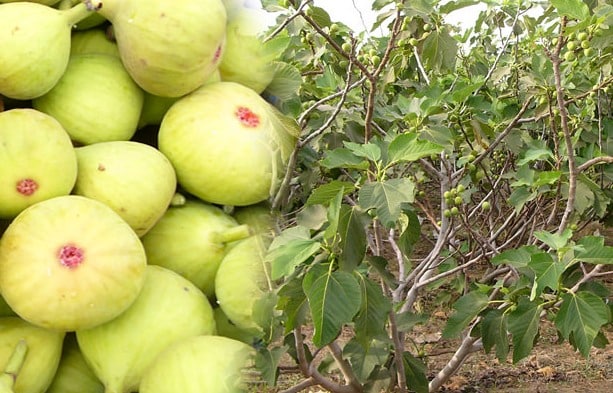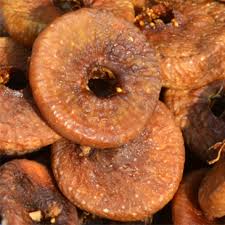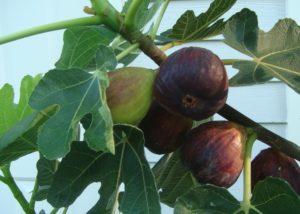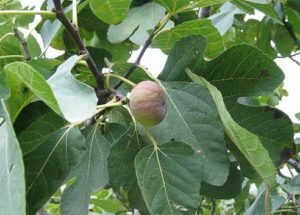Fig Farming (Anjeer) Information:

Introduction of Figs (or) Anjeer:- Figs are a delicious fruit like treat and popularly known as “Anjeer” in India. Fig fruit is one of the ancient fruits in the world. The fig fruit is unique, unlike most ‘fruits’ in which the structure is matured ovary tissue, and the fig’s edible structure is actually a stem tissue. Figs belong to family of Moraceae. They grow best in areas where long and hot summers are possible, though they can also be grown in containers. These fruits can be eaten fresh from the tree, preserved, and used in cooking. In India, fig fruit is considered to be a minor fruit crop and the commercial farming of common (edible) fig is mostly confined to Parts of Gujarat, Maharashtra, Uttar Pradesh, Tamilnadu, and Karnataka.
Health Benefits of Fig fruit or Anjeer:- Some of the health benefits of Anjeer or Fig are:

- Fig fruit improves digestion.
- Fig Fruit is rich in antioxidants.
- Fig fruit helps in preventing hypertension.
- Fig fruit may help in preventing heart disease.
- Figs may help in preventing cancer.
- Fig fruit helps in curing iron-deficiency.
Local Names of Fig in India:- Anjeer (Gujarati, Marathi, Urdu & Punjabi), Athi pallu (Telugu), Atti pazham (Tamil and Malayalam), Dumoor (Bengali), Dimiri (Oriya).
Varieties of Fig:- There are about 21 most popular varieties of fig that are being cultivated in the world. Some popular varieties of fig cultivated in different countries are Black Mission’ ‘White Adriatic’, ‘Kalamon’, ‘Kodota’, ‘Conadira’, Sultani. In India ‘Poona’ is the most popular variety cultivated for fresh fruit consumption. Most of the fig fruits grown in Daulatabad, Ganjam,Coimbatore,Mangalore, Bellary, Lucknow and Saharanpur resembles the Poona Fig. In recent days, a variety called ‘Dinkar’, an improvement over ‘Daulatabad’ variety for yield and fruit quality is gaining commercial importance.

Types of Fig or Anjeer:- Fig fruits have been grouped into 4 types based on the method of pollination and sex of the fig flower.
- Edible Figs (or) Common Figs: Individual flowers are long styled pistillate and fruits develop parthenocarpically. Popular varieties of figs are – Conardia,Poona, Kadota,Mission & Brown Turkey.
- Wild Figs (or) Capri Figs: These types are functional staminate flowers and short styled pistillate flowers, Capri figs are not eatable but grown because they harbour fig wasp (Blastophaga psenes), which is required for setting fruits and pollination.
- Smyrna Figs: Fig fruits develop only on Pollination by male flowers of Capri fig through the Fig wasp. Most important cultivar is ‘calimyrna’.
- San Pedro Figs: These are an intermediate fig type where the first crop is Parthenocarpic, while the second crop (main) needs pollination just like Smyrna type.
Climate requirement for Fig Farming:– Fig being a deciduous and sub tropical fruit tree, it prefers areas having high summer temperatures, plenty of sunshine and moderate irrigation. The fig fruit quality deteriorates beyond 39°C even though the fig tree survives up to 45°C. Fig tree grows best when the temperature range is between 15°C to 21°C . The shape, size, colour of the skin and pulp quality are affected by climate. But quality figs can be obtained in the regions with hot dry climates at the time of development and maturity stage of fig fruit. Low temperatures and high humidity conditions results in fruit splitting and low fruit quality of fruit.
Soil requirement for Fig Farming:- Fig crop is one of the most drought and salt tolerant crop. It can tolerate a fairly high levels of chloride salt or sulphate. Soils having pH value of 7 to 8, medium to heavy, well drained, calcareous is suitable for fig fruit cultivation.
Propagation in Fig Farming:- Propagated in Fig Farming is done by cuttings. About 25 cm in length cuttings having 3 to 6 nodes from the previous season should be used as planting material.
Plantation in Fig Farming:- Usually Fig tree should be planted in square system @ a spacing of 5 m x 5 m accommodating about 150 plants/acre. 0.6 cu.m pits should be dug for planting the fig tree cuttings. The best planting season for fig farming is June to September.

Manures and Fertilizers in Fig Farming:- The year wise manures and fertilizers application requirement is given below. Dosage is in kg/tree/year. (FYM = Farm Yard Manure).
| Year | FYM | Neem Cake | Nitrogen | Phosphorous | Potassium |
| 1 | 25 | 0.50 | 0.060 | 0.040 | 0.040 |
| 2 | 25 | 0.50 | 0.120 | 0.080 | 0.080 |
| 3 | 25 | 1.00 | 0.180 | 0.120 | 0.120 |
| 4 | 30 | 1.50 | 0.240 | 0.160 | 0.160 |
| 5th year onwards | 35 | 2.00 | 0.300 | 0.200 | 0.200 |
Irrigation in Fig Farming:- Fig has property of sustaining hot and drought conditions. For commercial cultivation, Irrigating the fig plantation is required. Irrigation @ an interval of 3 to 4 days during summer is mandatory. drip irrigation also should be considered for best production of fig. 15 to 20 liters of water/day/fig plant is recommended.
Training and Pruning in Fig Farming:- Initially, Fig plants should be trained to 1 stem and allowed to grow it to a height of 1meter and then it should be topped. Light pruning should be carried out in Poona variety cultivation after the rainy season is over, which is in October.
Pests and Diseases in Fig Farming:- The major pests of fig plantation are leaf defoliators, stem borers, and fig flies. The fig fly can be controlled with the application of Demecron (0.05% spray). The stem borer can be controlled by applying Phorate granules with Kerosene (or) Petrol. Main disease found in fig farming is rust and it can be controlled by spraying with Blitox or dusting with sulphur or Dithane Z-78 and Dithane M-45.
Growth regulator in Fig Farming:- To prevent fruit drop in fig cultivation and promote good shoot growth, use growth regulators “Gibberellic Acid (GA)” at 30 ml / litre of water.
Harvesting of Fig Fruit:- Normally fig tree starts bearing fruits from the 2nd year, commercial harvesting can be done from the 3rd year. The fruit yield increases with increase in canopy size of the tree and stabilizes during 8th year. The life span fig plant is about 30 to 35 years. The harvesting season starts in Feb to Mar and is over by May to June. The Fig fruits should be harvested in 2 to 3 intervals manually.
Yield of Fig Fruit: Age wise yield of Fig (kg/tree) is given below.
|
||||||||||||||
For Sheep Farming or Goat Farming Guide : Read Here.
yes good information, whr is the marketing in bangalore location, am thinkng about this
You should have some buyback contract with Supermarkets like More, Heritage Fresh. and other big stores.etc,
Where can we get good quality fig plant cuttings/sapplings for cultivation?
For fig planting material, try at nurserylive dot com.
hello
is it possible to grow cashew nuts successfully in Gujarat regions?
Well, climate and soil factors are important for growing cashew nuts. You can read more here for growing conditions of Cashew Nuts. Read: Cashew Farming.
Where can I get fresh figs in north Maharashtra in huge quantity?
Good morning
I need to know about figs varieties and how to plant figs.
Hi. Please tell me the lower temperature range that fig plant can tolerate.
Thanks
Hi..
Thanks for your information.
You have any organic farmers list farming near hyderabad 200km radius if any.
Village names if avialble.
Very Usefull and clear information about fig tree Thank you sir
Hi sir,
I am from tamil nadu,Karur dt,Now i started cultivating Fig plants ,Now i am getting minimum quantity of fruits,Please give some idea how to sell the fruits,Peoples are not aware of this fruit,Please give some solution.
how many inches of bore water required for 5 acre fig plantation
Respected sir.
i want to plant a fig fruit in Andhra pradesh. please suggests best ways please explain the prons and cons..
Can someone please tell me where I can buy I healthy fig plant for yielding sweet figs for home use. Miss my delicious fig tree in Delhi home, childhood days, Now currently at Bangalore.
Good info sir…Can we grow this Fig in Costal Andhrapradesh? Is that weather suits for Fig culitivation.
Please advice.
Thanks,
VK
My parents have planted fig trees they are about 4-5 years old it has a good yield too but I dunno what stage they are supposed to be harvested, in fact I don’t even know the type of these figs decided, decided to sell to some vendors they didn’t know the mandi value so they didn’t buy it so they are just getting wasted.
Dear respected Sir, Good morning !
i am from Nepal. i am interested to cultivate Fig fruit in 20 acres of land which is near by Raksoul (indian boarder in Bihar). The place is in about 10 km north from Boarder. how can i receive the information that guide me through the cultivation and marketing process? Your assistance in this regard will highly acknowledged. willing to have your cell number, if possible.
I have a 5 acre farm in Punjab(close to Himachal side, temperature varies – 4degree in Winters to 45degrees in Summer) and I want to set up a horticulture plantation.
The concern is that during rains my farm gets flooded but water recedes in a day after rains. the ground water level is pretty high – around 7 to 8 feet from top soil due to a natural rivulet flowing nearby. we get good output in both Wheat and Rice but I want to move to fruits.
Would fig be a good alternative for me, or would you suggest something else
Any good options for companion plantation with fig?